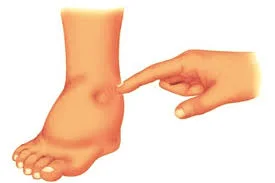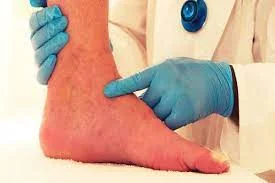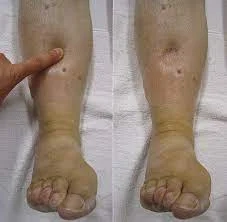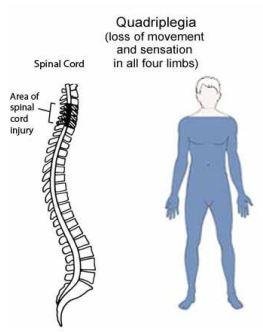Pitting vs Non-Pitting Edema
Table of Contents
Introduction
Oedema is a medical term that describes swelling caused by small blood vessels leaking fluid into nearby tissues.
Pitting edema occurs when the swollen skin is pressed with a finger, forming a pit. Non-pitting edema occurs when the swollen area is pressed but does not form a pit in the skin.
What is edema?
Oedema is a swelling that occurs when fluid accumulates in the body’s tissues, resulting in fluid retention or swelling.
Water makes up roughly 60% of the human body weight. Normally, the majority of the water in the body is inside the cells, about a third of it is outside the cells, and about 25% of it is blood fluid (plasma), with the remainder being intercellular fluid.
Oedema is characterized by an increase in the cytoplasm (the fluid inside the cell). Edoema appears on the outside only after a few litres of liquid have accumulated.
Oedema is swelling caused by small blood vessels leaking fluid into surrounding tissues.
Edoema manifests as local swelling, such as edema of the abdominal cavity known as “ascites” or edema of the pleura.
Edoema can be caused by a variety of factors, including warm weather, thyroid conditions, and the lymphatic system. Edoema is classified into two types: pitting and non-pitting.
Comparative Table between Edema and Non-Pitting Edema
| Feature | Pitting Edema | Non-Pitting Edema |
| Definition | Fluid accumulation in skin/subcutaneous tissues that leaves an indentation when pressure is applied | Fluid accumulation without indentation when pressure is applied |
| Location | Usually starts in feet/ankles, can spread to legs and arms | Usually starts in feet/ankles, can spread to legs and arms |
| Pressing on skin | Leaves a pit/indentation that takes time to rebound | No pitting, bounces back quickly |
| Common Causes | Heart failure, liver or kidney disease, malnutrition, medications | Venous insufficiency, lymphedema, lipedema, myxedema |
| Appearance | Skin is stretched, shiny | Skin may look thickened, irregular |
| Treatment | Treating the underlying cause, compression stockings, leg elevation | Compression stockings, massage, lymphatic drainage, diuretics |
| Notes | Can indicate a serious underlying illness | Harder to manage than pitting edema |
The main differentiating factors are that pitting edema leaves an indentation when pressed, while non-pitting does not. Pitting is more closely tied to systemic illnesses, while non-pitting is more localized. Both can start mildly but become more pronounced over time. Identifying and treating the root cause is important for resolution.
Pitting oedema vs. Non-Pitting oedema
What specifically is pitting edema?

When pressed, the swollen skin may leave a pit in the skin, a condition known as pitting edema, which responds well to elevation and diuretics.
Pitting edema can be caused by systemic issues with your heart, kidneys, or liver, or by a localized problem with the veins in the affected area.
Pitting edema can occur anywhere on the body, but it most commonly affects the lower body, specifically the feet, legs, and ankles.
Pitting oedema most commonly affects the lower body, specifically the legs, feet, and ankles.
Swelling in your body can cause the skin to feel tight, sore, or heavy as extra fluid collects in it.
Symptoms of pitting oedema vary depending on the cause, but may include:
- Pain and ache in swollen areas.
- Heart murmur, chest discomfort, or bruising in a limb.
- Skin feels warm or hot to the touch.
- Skin feels puffy or stiff.
- Shortness of breath and unexplained cough
- tingling or burning sensations around the swelling.
- Fatigue or reduced stamina.
- Numbness and cramps.
- Bloating and Water Retention
- Low blood protein levels, especially if the swelling is in the abdomen
- Pitting edema can be caused by several conditions, including low protein levels, heart valve problems, deep venous thrombosis (DVT), venous insufficiency, congestive heart failure, kidney failure, severe lung disease, and liver disease.
Assessment of Pitting Edoema
Grade 1+ Edoema: A pit of 2 mm or less, with slight pitting and no distortion. Pitting disappears immediately.
Grade 2+ Edoema: A deeper pit measuring 2 mm to 4 mm. It will have no discernible distortion, and the pitting will disappear within 10 – 15 seconds.
Grade 3+ Edoema: A deep pit measuring 4 mm to 6 mm. The affected area will appear noticeably larger and more swollen. The indentation can take up to a minute to disappear.
Grade 4+ Edoema: A bottomless pit appears, lasting 2 to 5 minutes before disappearing. This indentation will be 6 – 8 mm deep, and the body part affected by the edema
Pitting edema is difficult to diagnose because there is no definitive list of telltale signs. A physician, on the other hand, can detect pitting edema through a battery of tests and an in-depth examination that may include a chest x-ray, blood work, and a heart ultrasound. If you are diagnosed with pitting oedema, there are several treatment options available. Some treatments can be administered at home, while a licensed physician must perform others.
What is non-pitting edoema?

Non-pitting edema occurs when a finger is pressed against a swollen area and no pit is formed in the skin.
When non-pitting edema is relieved, the skin returns to its swollen shape without leaving an indentation.
Non-pitting edema is easily diagnosed because it is more commonly caused by three distinct conditions: lymphedema, myxedema, and lipedema.
Lymphedema
Lymphedema is swelling in one of your arms or legs caused by an accumulation of lymph fluid in the body or a blockage in the lymphatic system. Sometimes swelling occurs in both arms or legs.
Some people have lymphedema from birth, while others develop it as a result of surgery or as a complication of another condition.
Myxedema
Myxedema is skin swelling and soft tissue inflammation caused by a lack of thyroid hormone production in the body.
Most people with myxedema have hypothyroidism, both severe and advanced cases.
Lipedema
Lipedema is a disorder that causes non-pitting oedema. Lipedema is almost exclusively seen in women and is characterized by symmetrical leg enlargement caused by fat accumulation under the skin.
When fat cells accumulate abnormally in the hips, buttocks, and legs, they tend to hold more fluid.
These three types of non-pitting oedema can be identified by unusual swelling. When a doctor notices unusual swelling, he or she will review medical records and conduct a battery of tests to determine the cause. Lipedema is the most difficult to diagnose and requires a physical examination. During the exam, doctors will look for tender skin, excess weight, and bruises. Once non-pitting oedema is diagnosed, treatment options vary depending on the underlying condition and are determined by a trained physician.
Summary
Oedema is a medical term describing swelling caused by small blood vessels leaking fluid into nearby tissues. It is characterized by an increase in cytoplasm, the fluid inside the cell. Edoema, on the other hand, is swelling caused by small blood vessels leaking fluid into surrounding tissues. It can be caused by various factors, including warm weather, thyroid conditions, and the lymphatic system.
Pitting edema is a condition where the swollen skin is pressed with a finger, forming a pit in the skin. It can be caused by systemic issues with the heart, kidneys, or liver, or by a localized problem with the veins in the affected area. It can occur anywhere on the body, but most commonly affects the lower body, specifically the feet, legs, and ankles.
Pitting oedema can be assessed by grade 1+ oedema, grade 2+ oedema, grade 3+ oedema, and grade 4+ oedema. Treatment options for pitting edema include various treatments, some of which can be administered at home, while others require a licensed physician.
Non-pitting edema is more commonly caused by three distinct conditions: lymphedema, myxedema, and lipedema. Lymphedema is swelling in one arm or leg caused by lymph fluid accumulation or a blockage in the lymphatic system. Myxedema is skin swelling and soft tissue inflammation caused by a lack of thyroid hormone production in the body. Lipedema is almost exclusively seen in women and is characterized by symmetrical leg enlargement caused by fat accumulation under the skin.
FAQs
Pitting edema responds to pressure, whether from a finger or a hand, whereas pitting edema doesn’t. If you press your finger against your skin and leave an indentation, you may have to pit edema. Non-pitting edema, on the other hand, does not respond to pressure or leave an indentation.
Edoema is caused by vascular, cardiac, or liver problems. A variety of diseases can cause edema. Edoema is usually not a sign of a serious illness, but it can be.
They may apply pressure to the swollen skin for a few seconds to see if the indentation lasts. Because some associated conditions are more dangerous than others, it is critical to determine the root cause of the edema.
Volume and girth measurements are the most commonly used tools for measuring edema. Pitting edema is evaluated based on the depth and duration of the indentation.
Non-pitting edema is typically more difficult to treat than pitting edema. Pitting edema is frequently caused by an excess of water, so elevation and diuretics are effective treatments. Non-pitting edema, on the other hand, is frequently triggered by a thing beyond fluid, which complicates drainage.
References
- Difference between Pitting Edema and Non-Pitting Edema. (2023, January 10). The Scientific World – Let’s Have a Moment of Science. https://www.scientificworldinfo.com/2020/04/difference-between-pitting-edema-and-non-pitting-edema.html
- Facebook. (n.d.). https://www.facebook.com/100063517152445/posts/293197807715142/
- Specialists, O. (2018, July 5). Pitting Edema VS Non-Pitting Edema: What’s the Difference? Louisville Bones. https://louisvillebones.com/pitting-edema-non-pitting-edema/
- Gotter, A. (2018, March 7). What Is Non-Pitting Edema and What Causes It? Healthline. https://www.healthline.com/health/non-pitting-edema#complications
- Norris, T. (2017, August 31). Everything You Should Know About Pitting Edema. Healthline. https://www.healthline.com/health/pitting-edema#diagnosis





